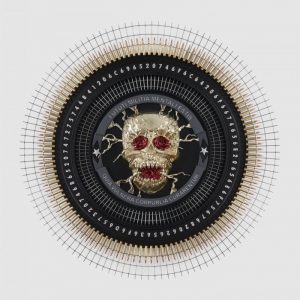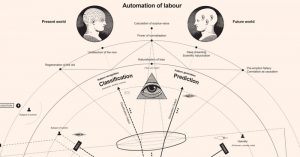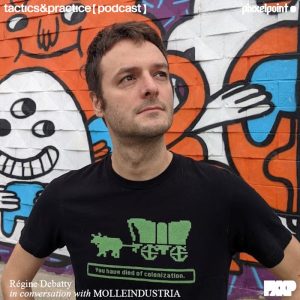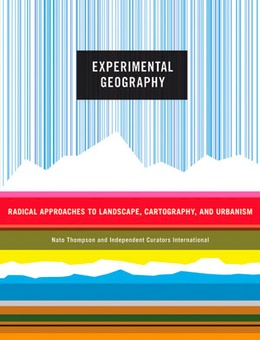 Experimental Geography: Radical Approaches to Landscape, Cartography, and Urbanism, by Nato Thompson, a curator and producer at Creative Time, and Independent Curators International. With essays by Trevor Paglen and Jeffrey Kastner (available on Amazon USA.)
Experimental Geography: Radical Approaches to Landscape, Cartography, and Urbanism, by Nato Thompson, a curator and producer at Creative Time, and Independent Curators International. With essays by Trevor Paglen and Jeffrey Kastner (available on Amazon USA.)
Publisher Melville House Publishing says: A photo of a secret CIA prison. A map designed to help visitors reach Malibu’s notoriously inaccessible public beaches. Guidebooks to factories, prisons, and power plants in upstate New York. These are some of the more than one hundred projects represented in Experimental Geography, a groundbreaking collection of visual research and mapmaking from the past ten years.
Experimental Geography explores the distinctions between geographical study and artistic experience of the earth, as well as the juncture where the two realms collide (and possibly make a new field altogether). This lavishly illustrated book features more than a dozen maps; artwork by Francis Alÿs, Alex Villar, and Yin Xiuzhen; and recent projects by The Center for Land Use Interpretation, the Raqs Media Collective, and the Center for Urban Pedagogy.
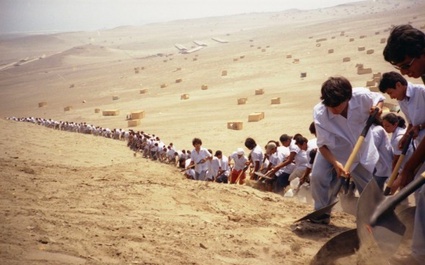 Francis Alÿs in collaboration with Cuauhtemoc Medina and Rafael Ortega, When Faith Moves Mountains, 2000-2002 (check out the video)
Francis Alÿs in collaboration with Cuauhtemoc Medina and Rafael Ortega, When Faith Moves Mountains, 2000-2002 (check out the video)
The book accompanies the traveling exhibition of the same name. You can catch it until September 20 at The Albuquerque Museum in New Mexico. A quick look at the calendar of the exhibition tells me that, alas, they have no plan to come to Europe. I’m usually weary of reviewing the catalog of an exhibition i’ve never visited. Just like i tend not to blog about artworks and events i’ve never experienced. This time however, i feel that the book stands on its own legs. Mostly because the field of experimental geography has not been overwhelmingly explored in publications. So i take what i can get get my hands on and didn’t find any reason to regret it.
Artist and geographer Trevor Paglen coined the term ‘experimental geography’ back in 2002 and given his experience in the field who better than him could define this emerging genre?
Experimental geography means practices that take on the production of space in a self-reflexive way, practices that recognize that cultural production and the production of space cannot be separated from each another, and that cultural and intellectual production is a spatial practice. Moreover, experimental geography means not only seeing the production of space as an ontological condition, but actively experimenting with the production of space as an integral part of one’s own practice. (More in his essay Experimental Geography: From Cultural Production to the Production of Space.)
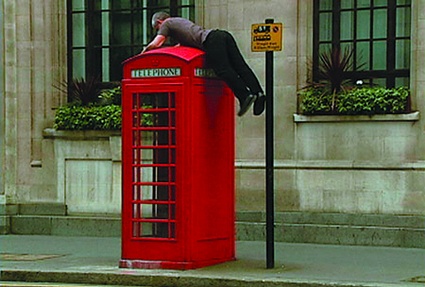 Alex Villar, Upward Mobility, 2002. Video Still
Alex Villar, Upward Mobility, 2002. Video Still
The fact that Paglen’s work has inspired the exhibition and the book, doesn’t prevent him nor the other authors of the volume to pay tribute to Walter Benjamin, Robert Smithson, Henri Lefebvre, Vito Acconci, Michel de Certeau and Guy Debord and of course the work and thoughts of the Situationists. However, many of the artists featured in the book do not stick strictly to the ideas and methods of the European artistic avant-garde. They are somehow much more pragmatic and show a greater commitment to engaging “everyday” people into the discussion.
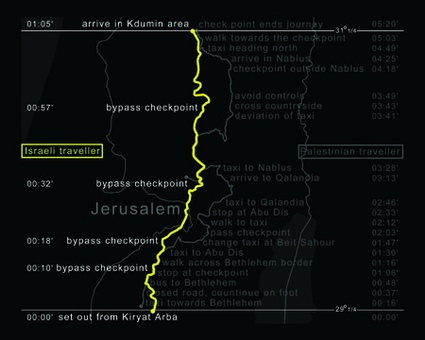 Multiplicity, The Road Map, 2003. Video Still
Multiplicity, The Road Map, 2003. Video Still
Among the projects i found most interesting is The Road Map by Multiplicity. In 2003 the Italian collective tried to measure, with their EU passport, the density of border devices in the area surrounding Jerusalem. They first traveled on the highway 60 along with a person with an Israeli passport from the colony of Kiriat Arba to the colony of Kudmin. The following day, they traveled along with a person with a Palestinian passport from Hebron to Nablus. Both routes start and end in the same latitude. Their traveling times, however, are different. The Israeli traveler took around one hour, while the Palestinian took five and a half hours.
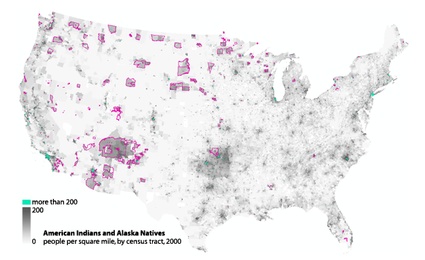 Bill Rankin, The United States? 2003-07. A map of self-identified Indians overlaid with the locations of U.S. Indian reservations
Bill Rankin, The United States? 2003-07. A map of self-identified Indians overlaid with the locations of U.S. Indian reservations
Another striking map is the one that Bill Rankin made to document the locations of U.S. Indian reservations. The kind of questions triggered by the map is particularly interesting: can a traditional map accurately represent the sovereignty rights (or claims) of indigenous peoples?
Experimental geography reflects the width of geography’s interdisciplinary approach. It is made of loads of maps (there’s a wonderful archive of artists, designers and activists maps online) but it also involves interventions in public space, bus tour, performances in urban areas and nature, etc.
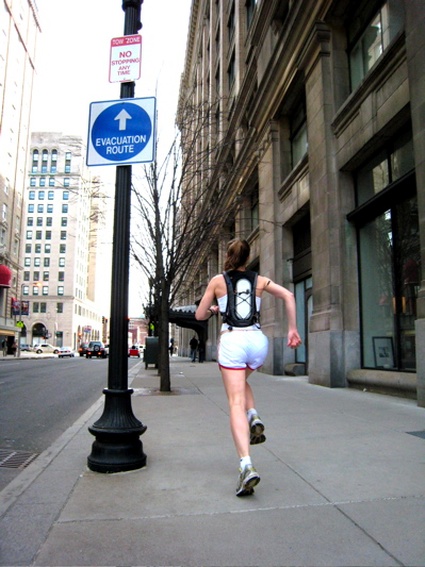 It takes 154,000 breaths to evacuate Boston by kanarinka (Catherine D’lgnazio) is a thought-provoking and probably quite exhausting performance. In 2007, kanarinka run the entire emergency evacuation system installed in the city to demonstrate the city’s preparedness for evacuating people in snowstorms, hurricanes, infrastructure failures, fires and/or terrorist attacks. By attempting to measure the distance in human breath, the artist also aimed to measure our post-9/11 collective fear.
It takes 154,000 breaths to evacuate Boston by kanarinka (Catherine D’lgnazio) is a thought-provoking and probably quite exhausting performance. In 2007, kanarinka run the entire emergency evacuation system installed in the city to demonstrate the city’s preparedness for evacuating people in snowstorms, hurricanes, infrastructure failures, fires and/or terrorist attacks. By attempting to measure the distance in human breath, the artist also aimed to measure our post-9/11 collective fear.
Experimental Geography is currently on view at The Albuquerque Museum, Albuquerque, New Mexico until September, 20, 2009.
Previously: Book Review – An Atlas of Radical Cartography, Trevor Paglen’s talk at Transmediale and Conflux 2008: notes from the panel Cartography of Protest and Social Changes.
Image on the homepage from the project You Are Probably Not Here by Nikolas R. Schiller.

